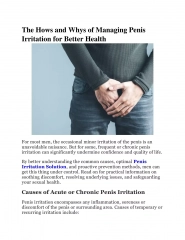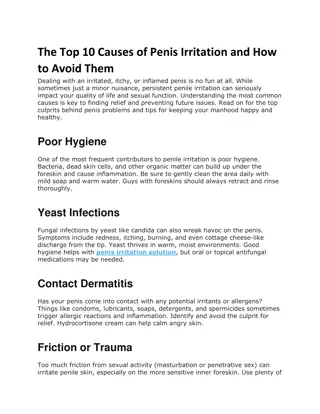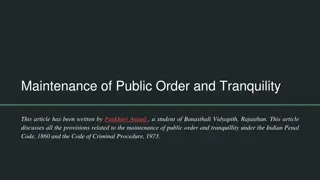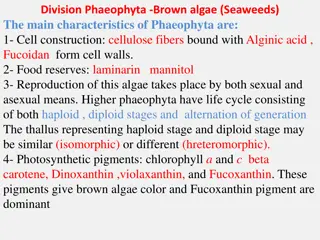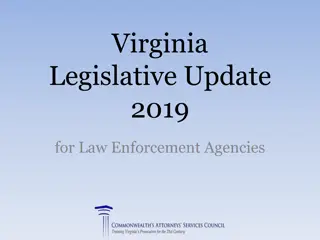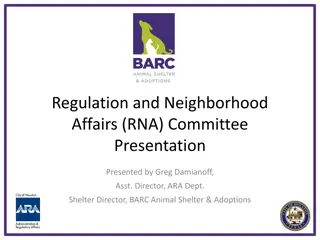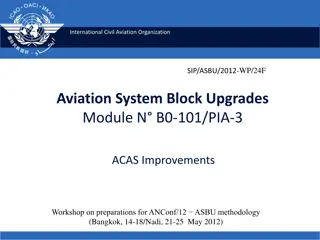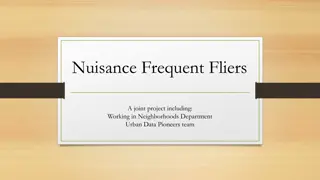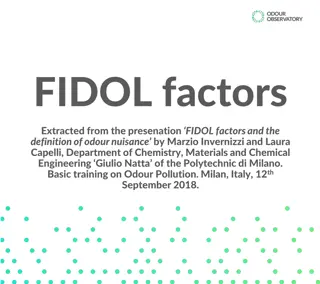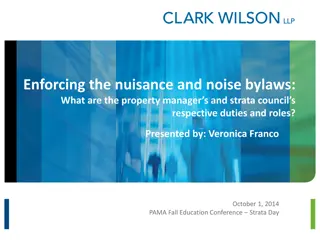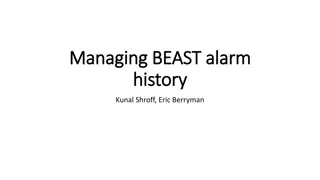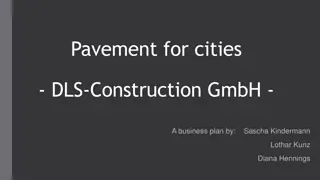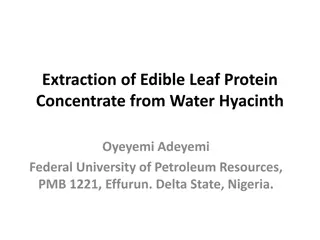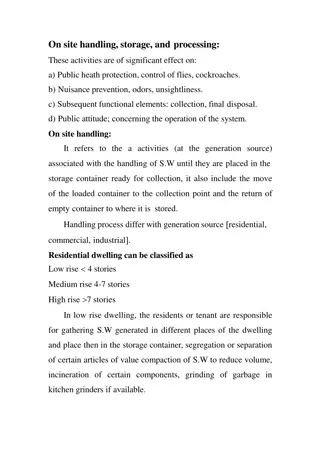Nuisance
The Tort of Nuisance in English law encompasses public and private nuisances, protecting landowners from unreasonable interferences. Actions range from flooding to noise disturbances, with distinct criteria for liability in private nuisance cases. The distinction between public and private nuisances, examples of actionable nuisances, parties involved, and the requirements for both claimants and defendants are key elements in understanding this area of tort law.
Download Presentation

Please find below an Image/Link to download the presentation.
The content on the website is provided AS IS for your information and personal use only. It may not be sold, licensed, or shared on other websites without obtaining consent from the author.If you encounter any issues during the download, it is possible that the publisher has removed the file from their server.
You are allowed to download the files provided on this website for personal or commercial use, subject to the condition that they are used lawfully. All files are the property of their respective owners.
The content on the website is provided AS IS for your information and personal use only. It may not be sold, licensed, or shared on other websites without obtaining consent from the author.
E N D
Presentation Transcript
The Tort of Nuisance There are two types of nuisance in English law: Public nuisance and Private nuisance. In some instances, the same set of facts can produce liability in both kinds of nuisance, although the two types of nuisance are very much distinct. Private nuisance is concerned with protecting the rights of an occupier in respect of unreasonable interference with the enjoyment or use of his land. The parties to an action in private nuisance are generally neighbours in the popular sense of the word and the courts undertake a balancing exercise between the competing rights of land owner to use his land as he chooses and the right of the neighbour not to have his use or enjoyment of land interfered with. Public nuisance is a crime but becomes actionable in tort law if the claimant suffers 'particular damage' over and above the damage suffered by the public generally.
The Tort of Nuisance A vast range of interferences are capable of amounting to an actionable nuisance. Some examples include: Nuisance from flooding - Sedleigh-Denfield v O' Callaghan [1940] Nuisance in the form of smells - Wheeler v JJ Saunders [1996] Encroachment by tree branches or roots -Lemmon v Webb [1894] Nuisance noise - Kennaway v Thompson [1981] Cricket balls - Miller v Jackson [1977] Disturbance from a brothel Thompson-Schwab v Costaki [1956]
The Tort of Nuisance Some interferences are not capable of giving rise to an actionable nuisance: Interference with television reception Hunter v Canary Wharf [1997] Interference with a view
The Tort of Nuisance Private nuisance: Claimant Private nuisance is essentially a land based tort. In order to bring a claim in private nuisance, a claimant must have an interest in the land in which he asserts his enjoyment or use has been unreasonably interfered with. Malone v Laskey [1907] This requirement was departed from in Khorasandjian v Bush but reinstated in Hunter v Canary Wharf
The Tort of Nuisance Private nuisance: Defendant A person with ownership rights in the land may be liable in nuisance even where they were not the creator of the nuisance if they authorised it: Tetley v Chitty [1986] (Go kart race track) The authorisation must relate to the nuisance, a landlord will not be liable merely for allowing occupation of the creator of the nuisance: Smith v Scott [1973] (homeless family, troublesome, LA not liable) Hussain v Lancaster City Council [1999] (racist attacks, not using tenants land, LA not liable)
The Tort of Nuisance Private nuisance: Defendant Similarly a landlord will not be liable for the noise created by a tenant, where the noise itself does not constitute a nuisance. London Borough of Southwark v Mills [1999] (lack of sound proofing, C could hear neighbours everyday noise incl toilet, no claim) A further way in which an owner or occupier may be liable for the acts of the creator of the nuisance is where they have adopted or continued the nuisance: Sedleigh-Denfield v O' Callaghan [1940] (pipe in land, overflow, D s knew of it s existence) Page Motors v Epsom Borough Council [1982]
The Tort of Nuisance Private nuisance: Defendant Similarly an owner or occupier may be liable for hazards naturally arising: Leakey v National Trust [1980] Goldman v Hargrave [1967] The owner or occupier is only expected to do what is reasonable taking into account their resources: Holbeck Hall Hotel Limited v Scarborough Borough Council [2000]
The Tort of Nuisance Unlawful interference Private nuisance requires an unreasonable use of land by the defendant which leads to an unreasonable interference with the claimant's use or enjoyment of their own land. This requires a balancing exercise of competing rights often referred to as the principle of give and take. Unreasonable interference alone is insufficient: London Borough of Southwark v Mills [1999] In assessing the reasonableness of the use and reasonableness of the interference, the courts take all the circumstances into account. In particular the courts will consider: The nature of the locality/neighbourhood Duration Sensitivity Malice
The Tort of Nuisance 1.Locality/Neighbourhood The reasonableness of the use of land will be assessed with regard to the nature of the locality in deciding whether there exists an actionable nuisance. As Thesiger LJ stated in Sturges v Bridgman, "What would be a nuisance in Belgrave Square would not necessarily be so in Bermondsey" Thus, for the purposes of nuisance, a higher level of disturbance is considered reasonable in an industrial area than would be regarded as reasonable in a residential area: Hirose Electrical v Peak Ingredients [2011]
The Tort of Nuisance The running of a brothel in a respectable residential area was held to constitute a nuisance: Thompson-Schwab v Costaki [1956]
The Tort of Nuisance Where the nuisance results in physical damage as oppose to amenity damage the locality is irrelevant: St Helen's Smelting Co v Tipping (1865) The position in relation to Art 8 European Convention of Human Rights was considered in: Dennis v Ministry of Defence [2003]
The Tort of Nuisance 2. Duration Most nuisances consist of a continuing state of affairs. In most instances the claimant is seeking an injunction to prevent the continuance of such nuisances. In general the longer the nuisance lasts the greater the interference and the greater the likelihood of it being held to be an unlawful interference. However, an activity which is temporary may constitute a nuisance: De Keyser's Royal Hotel v Spicer Bros (1914) (injunction granted re: building work at night despite only temporary ) Whilst a continuing state of affairs may be found in order to impose liability, Spicer v Smee [1946] (D s house suffered fire damage caused by defective wiring spread to claimant s house) A single act is capable of amounting to a nuisance. Crown River Cruises v Kimbolton Fireworks [1996] (20 min fireworks display causing damage to C s boats from burning debris)
The Tort of Nuisance 3. Sensitivity If the claimant is abnormally sensitive or their use of land is particularly sensitive, the defendant will not be liable unless the activity would have amounted to a nuisance to a reasonable person using the land in a normal manner. Robinson v Kilvert (1889) Network Rail v Morris [2004] If, however, the claimant has established that the defendant has infringed their right to ordinary enjoyment of the land, they can also claim damages for any damage incurred to unusually sensitive property: McKinnon Industries v Walker [1951]
The Tort of Nuisance 4. Malice Where the defendant acts out of malice, the actions are more likely to be held unreasonable: Christie v Davey [1893] Hollywood Silver Fox Farm v Emmett [1936] Public benefit Whilst the benefit to the community is not a defence it may be a factor considered when assessing if the use is reasonable: Miller v Jackson [1977]
ISAS Private Nuisance I D may be incur liability under private nuisance S This is an offence that has developed through case law but focuses on protecting the rights of an occupier in respect of unreasonable interference with the enjoyment or use of his land e.g Nuisance from flooding - Sedleigh-Denfield v O' Callaghan [1940] Nuisance in the form of smells - Wheeler v JJ Saunders [1996] Encroachment by tree branches or roots -Lemmon v Webb [1894] Nuisance noise - Kennaway v Thompson [1981] Cricket balls - Miller v Jackson [1977] Disturbance from a brothel Thompson-Schwab v Costaki [1956] A Claimants & Defendants; Malone v Laskey Unlawful interference; London Borough of Southwark v Mills set out rules to guide; 1. 2. (a) Locality; Thesiger LJ stated in Sturges v Bridgman, "What would be a nuisance in Belgrave Square would not necessarily be so in Bermondsey Hirose Electrical v Peak Ingredients (b) Duration; Most nuisances consist of a continuing state of affairs (Spicer v Smee) but an activity which is temporary may constitute a nuisance (De Keyser's Royal Hotel v Spicer Bros) (c) Sensitivity; If the claimant is abnormally sensitive or their use of land is particularly sensitive, the defendant will not be liable unless the activity would have amounted to a nuisance to a reasonable person Network Rail v Morris But once est. can recover for sensitivity to land McKinnon Industries v Walker (d) Malice; Where the defendant acts out of malice, the actions are more likely to be held unreasonable Christie v Davey Defences; Statutory Authority; Allen v Gulf Oil Refining, Local Authority planning permission; Planning permission may have the effect of changing the nature of the locality: Gillingham Borough Council v Medway Docks [1993], However, planning permission does not confer immunity from an action in nuisance and may not involve changing the nature of the locality: Wheeler v JJ Saunders [1996]/ Watson v Croft Promosport [2009], Act of a stranger, Volenti non fit injuria / Consent, Public Policy, The claimant coming fresh to a nuisance; Miller v Jackson [1977] Kennaway v Thompson [1981] S If found liable remedies may be sought in the form of damages, abatement or injunctions
The Tort of Nuisance Public nuisance The term public nuisance covers a wide variety of minor crimes that threaten the health, morals, safety, comfort, convenience, or welfare of a community. A public nuisance interferes with the public as a class, not merely one person or a group of citizens A-G v PYA Quarries Ltd; Romer LJ ..something that affect a reasonable class of Her Majesty s citizens materially or in the reasonable comfort and convenience of life Public nuisance does not have to be interference with the use and enjoyment of land, so it is not based on proprietary rights e.g. Rose v Miles [1815] Obstructing a canal by mooring a boat across a navigation channel
The Tort of Nuisance Public Nuisance - Key elements; 1. Substantial class of people affected 2. C suffers special damage above other members of the class Tate & Lyle v GLC e.g. (a) PI Castle v St Augustine Links (Car accident due to gold ball) (b) Damage to goods Halsey v Esso Petroleum Co Ltd (1961)(washing) (c) Financial loss Rose v Miles (Obstructing a canal by mooring a boat across a navigation channel) (d) Loss of trade connections Wilkes v Hungerford Market Co (1835)(Road repair blocked shop access) NB most commonly used for abuse of highway (a) Obstruction of highway Lyons v Gulliver (Queues for cheap theatre seats) (b) Projections over highway Noble v Harrison (branch of tree from D s land fell on bus: Not Liable) (c) Condition of highway Griffiths v Liverpool Corporation (tripped on flagstone)
The Tort of Nuisance 1. Substantial class of people affected Attorney General v PYA Quarries [1957] 30 Houses affected by dust, dirt and noise from quarry blast constituted a substantial class of people
The Tort of Nuisance 2. C suffers special damage above other members of the class Tate & Lyle v GLC e.g. (a)PI Castle v St Augustine Links (Car accident due to gold ball) (b)Damage to goods Halsey v Esso Petroleum Co Ltd (1961)(washing) (c)Financial loss Rose v Miles (Obstructing a canal by mooring a boat across a navigation channel) (d)Loss of trade connections Wilkes v Hungerford Market Co (1835)(Road repair blocked shop access)
The Tort of Nuisance Actions and Remedies As a common law crime it may be investigated by the police/CPS, or by the AG can seek an injunction on public s behalf. Alternatively it can be pursued as a civil claim by an individual; Tate & Lyle v GLC [1983] D caused a river to become silted, thus interfering with public navigation rights. C suffered special loss as it had to pay for dredging works to allow ships to reach its jetty. Castle v St Augustine Links (1922) Golf tee too near road, resulted in golf ball hitting C s car, entitled to damages as it was his car of all cars on the road that was hit. Violators may be punished by a criminal sentence, a fine, or both. A defendant may also be required to remove a nuisance or to pay the costs of removal, or meet the terms of an injunction.


